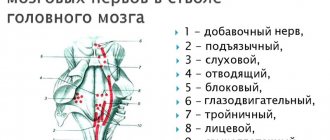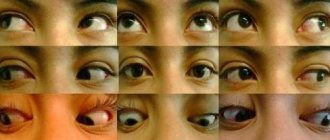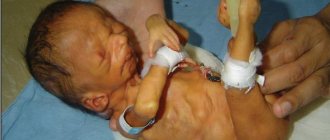Carpal tunnel syndrome is the development of median nerve neuropathy as a result of compression in the carpal tunnel by a thickened transverse ligament. This is the most common compressive neuropathy of the hand. It is observed in middle-aged people, more often among women. In 50% of cases it develops on both sides, but is more pronounced on the dominant one. A right-hander has the right, a left-hander has the left.
Carpal tunnel syndrome - what is it?
The name of the pathology comes from the anatomy of the hand. Tendons and the median nerve extend from the shoulder along its length, innervating the carpal components and fingers, except for the little finger and part of the ring finger (if anxiety comes from them, we are talking about another ailment). In the wrist area they run through a narrow channel. Carpal tunnel syndrome occurs when the carpal tunnel narrows and compresses these fibers.
Pressure on the nerve is exerted by the bones, tendons, and transverse carpal ligament. Under the influence of various factors, the volume of one or more of these elements increases.
Carpal tunnel syndrome occurs more often in women than men, and, as a rule, after the age of 35. The gender difference is associated with a tighter carpal, or carpal, opening.
But since children start using computers and smartphones from preschool years, the disease is becoming much younger. Posture in adolescents is disturbed, the skeleton is formed with distortions, which cannot but affect the quality of joints in the near future.
Causes and risk groups
Causes of carpal tunnel syndrome:
- Swelling due to injury to the forearm and hand.
- Tissue swelling in pregnant women, especially in later stages, and in women using oral contraceptives.
- Chronic inflammation and swelling of the carpal tunnel structures due to constant occupational trauma.
- Tissue swelling as a consequence of certain diseases of internal organs, endocrine disorders.
- Narrowing of the synovial membranes of tendons and thickening of their walls due to acute or chronic inflammation with systemic connective tissue disorders, metabolic disorders, and tuberculosis.
- Discrepancy between the size of the canal and the size of its contents due to genetically inherited characteristics or abnormal growth of the bones of the hand and wrist.
- Tumor of the median nerve.
Salt treatment for joints can be effective and safe if you follow our tips and recommendations.
What is knee contracture and how can you minimize the possibility of its occurrence after an injury? By following our recommendations, you can quickly and painlessly begin to move after a fracture.
Risks of occurrence include:
- use of force;
- pose;
- wrist position;
- monotony of action;
- hypothermia;
- vibration.
At-risk groups:
- people with a genetic predisposition;
- people of short stature, overweight;
- people suffering from tuberculosis, kidney failure;
- people with rheumatoid arthritis, problems with the thyroid gland;
- women during menopause and when using hormonal contraceptives.
Anatomy of the wrist
Causes of carpal tunnel syndrome.
The disease does not strike overnight, but develops over a long period. People whose activities cause pressure on the base of the palm are primarily at risk:
- Computer mouse workers: from PC operators and programmers to devotees of many hours of leisure time at the computer;
- Cashiers in supermarkets;
- Drivers, builders (especially those working with vibration equipment), musicians, hairdressers;
- Those who like to spend time with a mobile phone;
- Knitters, seamstresses.
It is mainly the right working hand that suffers (or the opposite hand in left-handed people) if the wrist is extended for a long time or monotonously at an angle of at least 20 degrees. But if the destruction is caused by internal disorders, the disorder has a chance to affect any limb, regardless of the load.
Additionally, the following circumstances influence: hormonal imbalance, pregnancy, excess weight, swelling, allergies, arthritis, diabetes, tumors (including benign ones, for example, fatty tissue), autoimmune diseases and other disorders. Once applied bandages, wounds, fractures, and dislocations also leave their mark. Bone connections are deformed - they bend or increase in volume, which disrupts blood flow or the structure of the nerve itself.
The situation is also complicated by an unhealthy lifestyle: alcoholism, physical inactivity, smoking. The situation is aggravated when one factor is superimposed on another - for example, if an individual suffering from obesity and edema types for several hours every day in an uncomfortable position.
Carpal tunnel syndrome is a disease that also affects the legs. In this case, the nerve fibers innervating the leg from the pelvis to the foot are affected. Compression occurs in the joints - hip, knee, ankle, hips, feet, fingers go numb.
Few people think that such a seemingly insignificant defect is a reflection of problems in the body or a signal that requires attention to the entire body, and not just to the disturbing element.
Risk factors
Carpal tunnel syndrome most often occurs in people at risk:
- with a hereditarily narrow anatomical structure of the carpal tunnel;
- As you age, your chances of getting sick increase;
- overweight people;
- professions where the hand works, repeatedly bending and unbending;
- patients with chronic diseases associated with nerve damage;
- people who have had inflammatory diseases affecting the tendons;
- people who are passionate about computer games and keyboard work;
Carpal tunnel syndrome often occurs in people who work a lot on the computer or are heavy computer gamers.
- pregnant or menopausal women suffering from edema.
Symptoms
It is not difficult to independently determine whether you have carpal tunnel syndrome. Damage manifests itself for the first time both during work activity and at rest at night; sudden pain can wake a person. Or at some point he simply cannot handle the keys, fasten the buttons and perform other basic actions.
The sensitivity of the palm and fingers decreases, they cannot be controlled, difficulties appear in holding things, and a noticeable, often painful tingling sensation spreads.
Sometimes the temperature of the hand surface changes, remaining significantly higher or lower than normal, and the skin tone changes.
If you shake or rotate a numb limb, control over it returns due to a rush of blood, but after some time the situation repeats itself. Gradually, attacks become more frequent, and self-help measures and treatment are less effective. Ultimately, the elbow and shoulder are also affected, affecting bundles of nerve fibers up to the brachial plexus.
With carpal tunnel syndrome, its carrier also faces deterioration in sleep, persistent fatigue, decreased productivity and motivation, helplessness, work pressures, loss of a favorite activity, inability to concentrate on anything other than one’s illness, and ultimately depression.
What indicates the appearance of the syndrome?
What signs can be used to determine the occurrence of cubital tunnel syndrome?
The development of the disease occurs gradually. The initial period is marked by weakness in the forearm muscles and loss of sensitivity. At the same time, it is often difficult for a person to hold any objects, write with a fountain pen, work with a keyboard, and other actions that require the participation of fine motor skills of the hands. Further symptoms of cuban syndrome may appear:
- painful sensations on the inner surface of the hand;
- a feeling of numbness in the little finger and partial loss of sensation in the ring finger;
Feeling of numbness in the little finger and partial loss of sensation in the ring finger
- movement of the hands causes pain and weakness is felt when gripping, attempts to bend and straighten the fingers are difficult;
- a feeling of tightness in the elbow, pain in the cubital tunnel.
Symptoms of cubital tunnel syndrome may increase. In the morning its manifestations are more pronounced. This is due to the fact that during night sleep the elbow is often in a bent, tense position (arm under the pillow or under the cheek). After some time, the symptoms gradually weaken.
It is important to identify symptoms in time (at the initial stages of the disease) and begin treatment. Otherwise, the symptoms will progress and therapy will require a long period.
Diagnosis of the disease
In mild cases, neither the patients themselves nor the doctor usually bother with a thorough examination. The goal is to alleviate symptoms and maintain ability to work. As a rule, the sufferer does not seek help at all until the situation becomes critical.
Determining the nature of the tunnel syndrome is necessary to prescribe an effective treatment course and exclude severe pathologies (oncology, heart attack, etc.), since the symptoms may overlap. In the presence of chronic disorders that provoke narrowing of the carpal tunnel, attention should be paid to them along with the location of the lesion.
Carpal tunnel syndrome itself is examined by a number of tests: Tinel, Durkan and Phalen - to clarify the localization of pain and the circumstances of its occurrence (at rest, during movement). The disease is also diagnosed with the help of maximally inflated tonometer cuff and raising the arms: if discomfort appears in them within a minute, the diagnosis is confirmed.
The conductivity of nerve signals is determined by electroneuromyography, muscle contractility by electromyography, and the condition of the tissues of the wrist or other area by ultrasound.
Additional tests are prescribed:
- for sugar content (if diabetes is suspected);
- thyroid hormones plus ultrasound examination;
- for rheumatic tests to detect autoimmune disorders such as arthritis;
- to assess renal function.
Diagnostics
A neurologist performs 4 special tests:
- The person raises his hands up and holds them in this position. After a few seconds, numbness is felt in the fingers. This sign confirms the presence of carpal syndrome.
- The doctor taps the narrowest area of the wrist from the palm side. If tingling appears in the thumb, middle and index fingers, then the Tinel test is considered positive.
- The next step is for the patient to strongly bend the arm at the wrist, after 1 minute. numbness and tingling appear in the affected area. Phalen test.
- The last test is called a cuff test. A tonometer cuff is put on, as when measuring pressure parameters, and air is inflated. With significant compression of the hand, paresthesia is felt in the fingers, which depend on the median nerve.
These tests are simple and can be used at home for self-monitoring. If one of the tests gives a positive result, this is a reason to consult a doctor.
To clarify the diagnosis, a neurologist will prescribe:
- complete urine analysis;
- blood biochemistry test;
- detailed blood test from a finger prick;
- blood for thyroid-stimulating hormones;
- Ultrasound, MRI, X-ray.
- testing for C-reactive protein.
Treatment methods
How treatment will proceed depends on the stage of the disease.
- If you occasionally experience unpleasant but weak sensations, especially during or immediately after exercise, you need to reduce tension, take frequent breaks from work, optimize your work space, and do not forget about joint exercises.
- The second stage is spoken of when the symptoms already cause serious inconvenience: tingling and pain wake you up in the middle of the night, and during work activities the limb periodically “fails,” forcing its owner to take sick leave. It is with this development of events that the doctor prescribes anti-inflammatory drugs or injections, physiotherapeutic measures and fixes the affected area. Pain relievers and relaxers are also prescribed.
- The extreme degree is characterized by an almost absolute loss of mobility and unbearable lumbago and burning, which can only be relieved briefly with medication. The only salvation is an operation to expand the tunnel channel.
Surgery and the above therapy can help and alleviate symptoms until a feeling of complete recovery. However, it is worth remembering that medications do not have a local effect on the affected area, so unwanted reactions are possible.
If the tunnel symptom complex arose as a consequence of an internal disease or provoking factors and bad habits persist, most likely very soon it will make itself felt again.
Relapses have a worse prognosis than the newly diagnosed syndrome.
Is it so easy during and after treatment to abruptly and permanently quit smoking and alcohol, engage in physical exercise on a regular basis and control the minutes and hours spent doing activities that overload a vulnerable area? How about trying to eliminate deep-seated problems in health? Or not go through with surgery at all, because the results are essentially unpredictable.
No matter how gentle the operation, it is a violation of the integrity of the tissue, and the subsequent scar is an injury that gives rise to a chain of new failures in the future.
Complex treatment requires the participation of various specialized specialists, each of them is responsible only for “their” organs and systems. And the patient came simply with discomfort in the wrist. It is difficult to imagine that for the sake of his diagnosis a council will gather and consider the problem from the perspective of the unity of the body. Apparently, they will simply treat the source of his suffering.
Osteopathic medicine offers gentle procedures for correcting the syndrome through rehabilitation of all vital systems.
Manifestations and diagnosis
Clinical manifestations depend on the location of the lesion. The main symptom defining the syndrome is pain. In this case they can arise:
- paroxysmal or shooting;
- regularly, aching type of pain;
- in the form of a burning sensation;
- as sensory disturbances (dysesthesia).
Tunnel form of neuropathy
If the nerves involved in the stimulation of muscles are pinched, then consequences such as loss of strength and muscle atrophy are possible. When veins and arteries are compressed, vascular disorders can develop. In this case, a decrease in temperature in the affected area appears, the skin becomes pale or cyanotic, and the limb swells.
To determine tunnel types of neuropathies, diagnostic tests have been developed:
- When pressing with a finger, local pain appears at the site of compression.
Diagnosis of tunnel neuropathy
When tapping (percussion) of the affected area, numbness, tingling or crawling occurs in the innervated area.
- Provocative tests. Their use allows you to accurately determine the location of compression. Pain and paresthesia intensify in the localization area.
- Injections containing lidocaine and hydrocortisone. Injected into the intended area of nerve compression. When identifying the compression zone, they help to significantly reduce pain.
- Electroneurography. This procedure allows you to determine the speed at which the impulse travels along the nerve trunk and determine the extent to which it is affected.
Based on their location, the following tunnel neuropathies are most often identified:
wrists – 45% of identified cases of pathology;
- ulnar nerve tunnel syndrome – 15%;
- peroneal nerve – 10%;
- tibial nerve - about 7%;
- in the groin area – 7%;
- brachial (radial) nerve – 4%.
It must be taken into account that in some cases, pain in the wrist or forearm can be caused by osteochondrosis, which manifests itself in the cervical region.
With this condition, it is possible that nerve roots in the spinal canal are irritated, but pain impulses are sent to other parts of the body. To identify instability of the cervical spine, it is necessary to additionally perform magnetic resonance imaging of the affected area.
Treatment of carpal tunnel syndrome at the Osteopathy Center
People turn to osteopaths both at the first alarm bells and in desperation after several unsuccessful attempts at traditional treatment. In the first case, the effect is achieved easier and faster, often in a single session. Difficult cases require repeated appointments and gradual progress towards healing.
In our clinic, treatment is carried out by doctors with education and experience in the field of traumatology and neurology, so they can sensibly assess the need and risks of various types of medical care.
The basis of successful treatment is always to find the root cause of the disease and eliminate it. Is it really possible to do this without laboratory and hardware research?
An osteopathic doctor diagnoses the presence and origin of pathology, studies muscle density and tone, joint mobility, and the condition of passing nerve fibers.
As a rule, the problem disappears immediately after the doctor releases the nerve using safe manual manipulations. But we are not only talking about the tissue structures surrounding the directly affected area. It is necessary to establish cause-and-effect relationships in the body and find other weak points, understand why a pinched nerve occurred in one or another department, why, for example, when bending the wrist, parts of the shoulder muscles tense, etc.
Treatment of carpal tunnel syndrome is not limited to interaction with the musculoskeletal system. A variety of osteopathic techniques are used, because the cause is hidden anywhere: in a change in the position and mobility of internal organs, in the displacement of cranial plates, in disruption of blood flow through the vessels, etc. Each of the defects tends to cause global degenerative processes, which ultimately become factors in the development of the tunnel syndrome.
Coming to an osteopath with a complaint of pain in the wrist joint, fingers or any part of the hand, an unprepared patient may be surprised by the doctor’s increased attention to his head or pelvis.
But a specialist needs to evaluate and, if necessary, restore the patency of the spinal canal for the free flow of cerebrospinal fluid in it, washing the brain and spinal cord.
Liquid, or cerebrospinal fluid, is produced in the ventricles of the brain and moves along the spine in a certain rhythm - 6-12 cycles per minute. The rhythmic emissions of each portion correspond to the pulsation of the cerebral arteries and the micro-expansion/constriction of the skull due to the soft sutures connecting the bones. These movements are not felt by a person, but are no less important than breathing and heartbeat.
It is the craniosacral therapist who adjusts the cranial plates, regulating the circulation of cerebrospinal fluid, the violation of which leads to severe dysfunction in the sphere of blood supply, the activity of many organs and systems, and self-regulation mechanisms are disrupted.
Visceral osteopathy is aimed at normalizing the functioning of the internal organs. Since the body is viewed through the prism of integrity, one element can influence any phenomenon or deviation. Disturbances in the functioning of the kidneys cause swelling, spasms of blood vessels and connective tissues interfere with the functioning of the heart, and constricted breathing does not allow one to straighten one’s shoulders. The osteopath frees the organs from spasms of nearby tissues, setting the necessary trajectory of movement - this not only solves the problem of carpal tunnel syndrome, but also eliminates other long-term diseases.
Treatment using structural techniques is aimed specifically at the bone and muscle components.
These restorative procedures are effective against joint inflammation both in individual arms, hands, fingers, and the whole body. Under the manual influence of the doctor, the muscle relaxes or is toned, the ligament or tendon is stretched or contracted - and thus the systems come into balance, the ability of natural self-regulation - neuro-humoral - increases.
Symptoms of damage to large nerves of the upper extremities
⇐ PreviousPage 10 of 10As noted above, damage or compression of the ulnar nerve most often occurs in four places: 1) in the posterior region of the elbow when the medial epicondyle of the humerus or olecranon is fractured, 2) in the muscle tunnel formed at the junction of the humeral and ulnar heads m. flexor carpi ulnaris in the anterior ulnar region, 3) in Guyon's canal in the anterior wrist, and 4) in the hypothenar region, where the nerve lies relatively superficially and may be susceptible to injury.
Complete damage to the ulnar nerve causes weakening of palmar flexion of the hand due to loss of function of the m. flexor carpi ulnaris (flexion is maintained partially due to the m. flexor carpi radialis and m. palmaris longus, innervated by the n. medianus), lack of flexion of the main phalanges of the IV and V, and partly of the III fingers due to paralysis of the lumbrical and interosseous muscles, inability to reduce and abduction of fingers, especially V and IV (paralysis of the interosseous muscles), inability to adduct the thumb (paralysis of the m. adductor pollicis).
As a result of atrophy mm. interossei and lumbricales, as well as the hypothenar muscles, and with hyperextension of the main phalanges, flexion of the middle and terminal phalanges is observed, as a result of which the hand takes on the appearance of a “clawed, bird’s paw.” At the same time, the fingers are slightly separated, especially the IV and, mainly, V fingers are abducted (Fig. 3.52).
Superficial sensitivity is usually impaired in the skin of the fifth and medial half of the fourth finger and the corresponding medial part of the hand.
Damage to the radial nerve most often occurs with a fracture of the humerus in the middle third (here the nerve is directly adjacent to the bone) and with a fracture of the neck of the radius. In this case it may
Rice. 3.52. "Bird's foot, or clawed foot" with damage to the ulnar nerve
Rice. 3.53. “Dangling hand” with damage to the radial nerve
Rice. 3.54. “Preacher’s hand” for median nerve damage
the deep branch of the radial nerve may be damaged. However, the leading symptoms will be the same: due to a violation of the innervation of the extensor muscles of the wrist and fingers, the hand acquires the typical hanging shape of a “seal’s paw” (Fig. 3.53), abduction of the thumb is also impossible (paralysis of the m. abductor pollicis longus). The sensitivity of the skin of the hand is impaired only when the radial nerve is damaged proximal to the elbow joint, since the function of the sensitive superficial branch of the radial nerve is lost.
When the median nerve in the ulnar region and the anterior region of the forearm, pronation and palmar flexion of the hand are affected, flexion in the distal interphalangeal joints of the 2nd and 3rd fingers is lost due to impaired innervation of the m. flexor digitorum superficialis and m. flexor digitorum profundus on the radial side. It is impossible to oppose the first finger and bend the terminal phalanx of the first finger (paralysis of the m. flexor pollicis longus et brevis). Flexion of the fingers in the proximal interphalangeal joints of the second and third fingers is also lost due to paralysis of the first and second lumbrical muscles. Thus, when you try to clench your fingers into a fist, the 2nd and 3rd fingers remain straightened: the “preacher’s hand” symptom
(Fig. 3.54).
Atrophy of the thenar muscles, loss of the function of opposing the first finger, impaired flexion of the fingers, bringing the thumb close and in one plane to the index finger give the hands a flat appearance.
Rice. 3.55. “Monkey hand” for lesions of the median nerve
ky species, which is designated as the “monkey hand” symptom (Fig. 3.55).
Sensitivity is lost on the palmar surface of the 1st, 2nd and 3rd fingers and the adjacent half of the 4th finger. On the dorsum of the fingers, the skin sensitivity of the terminal phalanges of the II, III and IV fingers disappears. Trophic disorders appear - dryness and coldness of the skin, peeling, cyanosis.
With even lower lesions of the nerve (carpal tunnel syndrome), the function of flexion of the terminal phalanges of the I, II and III fingers (m. flexor pollicis longus and m. flexor digitorum profundus) may be preserved, and then all symptoms of the lesion are limited to damage to the muscles thenar, mm. lumbricales and sensory disturbances in the typical zone.
— OPERATIONS ON THE UPPER LIMB —
Joint punctures are used to determine the nature of the contents of the joint cavity, to evacuate pathological fluid, administer medications, and also to introduce instruments for arthroscopy. As with all other punctures, the needle is inserted through the skin displaced by the finger above the puncture site, so that when the skin returns to its place, there is no direct wound channel through which infection could enter the joint cavity. In most cases, the needle is inserted through a previously anesthetized area of skin on the extensor surface of the joint, where there are no large vessels and nerves.
Puncture of the shoulder joint. The puncture is performed with the patient lying on the healthy side or sitting; it can be performed from the front, outside and behind.
In front, the shoulder joint is punctured, focusing on the coracoid process of the scapula, which is palpated in the subclavian fossa 3 cm downward from the acromial end of the clavicle. The needle is inserted under the coracoid process and advanced posteriorly between it and the head of the humerus to a depth of 3-4 cm.
Rice. 3.56. Puncture of the shoulder joint. Explanation - in the text
Rice. 3.57. Puncture of the elbow joint. Explanation - in the text
When puncturing the joint from the outside, the needle is inserted downwards from the most convex part of the acromion in the frontal plane through the thickness of the deltoid muscle.
When puncturing the shoulder joint from behind, the needle is inserted downwards from the acromion, into the recess formed by it and the posterior edge of the deltoid muscle, perpendicular to a depth of 4-5 cm (Fig. 3.56).
Puncture of the elbow joint. The arm is bent at the elbow joint at a right angle. From behind, the puncture is made above the apex of the olecranon process and the needle is directed forward. From the back from the outside, the needle is inserted between the lateral epicondyle of the humerus and the olecranon process of the ulna and penetrates the joint above the head of the radius (Fig. 3.57).
⇐ Previous10
Treatment of the spirit through physiology
According to osteopathic science, the body stores powerful reserves that only need to be awakened.
After therapeutic or preventive sessions, many patients improve their mental activity, physical and mental performance, and self-control. Emotional uplift and lightness are felt, a “second wind” opens.
Mysticism or self-hypnosis? No, simple physiology:
- The brain is fully supplied with oxygen and is freed from venous blood with metabolic products and excess cerebrospinal fluid;
- Spasms are relieved, flexibility and freedom of movement are restored;
- Hormones return to normal, you can breathe in full force, sleep brings rest and relaxation;
- Blood and lymph flow are normalized, and at the same time nutritional and protective functions.
Regularly people come to us only with a complaint of pain in the hand or numbness in the palm. At the first visit, the osteotherapist identifies and corrects the internal chronic process that provoked the onset of the painful syndrome.
There is also a nice bonus with osteosessions. Having undergone treatment of the wrist using traditional medicine methods, with the support of osteopathy, it will be easier for the patient to follow the recommendations:
- Measure the load, finally start organizing a comfortable workplace;
- Do regular warm-ups - therapeutic and general;
- Move in the fresh air, saturating yourself with oxygen;
- Monitor your diet in order to lose weight and give tissues elasticity and flexibility;
- Give up harmful tendencies;
- Listen to your body and its needs - avoid discomfort, avoid stagnation.
Osteopathic therapy has a beneficial effect on the emotional-volitional sphere, awakening awareness only through the regulation of hormonal levels and cerebral circulation.
Therapy is powerless to restore full mobility and tactility if the disease progresses, but the state of health improves significantly, and there is an opportunity to find oneself in a new activity.
How to prevent the syndrome?
You shouldn’t wait until the pain manifests itself, and then find time for procedures and sort through medications in search of the right one.
The danger of the syndrome is that, starting with quickly passing unpleasant sensations in the hand, it can quickly immobilize the entire hand and lead to disability. Release of the median nerve over a large area will require more serious neurosurgical intervention and a difficult rehabilitation period without hope of recovery and a full life.
In addition to everyday self-care, it is important to undergo preventive examinations from reliable specialists.
But the syndrome cannot be predicted; it is unrealistic to examine every living cell and detect pathological changes in the carpal tunnel. Periodic visits to an osteopath, even if nothing bothers you, will allow you to identify minor problems in advance and correct the situation without allowing the ailment to develop.
Does a child need an osteopath? Necessarily. A short preventive session will direct the energy of the growing body in the right direction. This is especially important during periods of increased stress - at the beginning of school, in graduation classes. Many developmental defects originate from the prenatal and birth periods. Uncorrected, they provoke multiple pathologies in adulthood. And a person’s fate could be changed by a 20-minute painless treatment.











